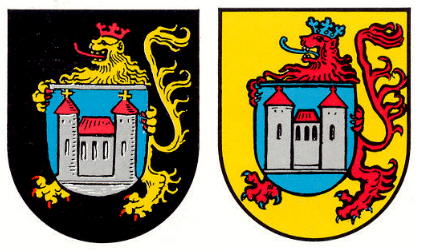Münsterappel: Difference between revisions
Knorrepoes (talk | contribs) m (Text replacement - "{{de}}" to "") |
Knorrepoes (talk | contribs) m (Text replacement - "|'''English''' ↵| {{blazon wanted}}" to "|'''English''' | blazon wanted") |
||
| Line 16: | Line 16: | ||
|- | |- | ||
|'''English''' | |'''English''' | ||
| | | blazon wanted | ||
|} | |} | ||
Revision as of 06:24, 8 April 2023
MÜNSTERAPPEL
State : Rheinland-Pfalz
District (Kreis) : Donnersbergkreis (until 1969 Rockenhausen)
Verbandsgemeinde : Verbandsgemeinde Nordpfälzer Land (until 2020 Verbandsgemeinde Alsenz-Obermoschel)
| German | In Gold ein blaubewehrter, -bezungter und -bekrönter roter Löwe einen blauen Schild haltend, darin eine zweitürmige rotbedachte silberne Kirche (Münster). |
| English | blazon wanted |
Origin/meaning
The arms (above right) were officially granted on July 4, 1953. The arms above left were never officially granted, but were in use until 1953.
The arms are based on the oldest known seal of the village, dating from 1537. The church is the local church (Münster), which was owned by the St. Maximinius Abbey in Trier, which also owned a large part of the area in late medieval times. Their possessions later became owned by the Rheingrafen ('Counts of the Rhine'), who partially gave the area in loan to the counts of the Pfalz.
The golden lion in black is the lion of the Pfalz, the red lion in gold, the arms of the Rheingrafen. As the seal was made at a time when the area was primarily ruled by the Rheingrafen, the arms were granted in 1953 with their arms.
Literature: Debus, 1988.
